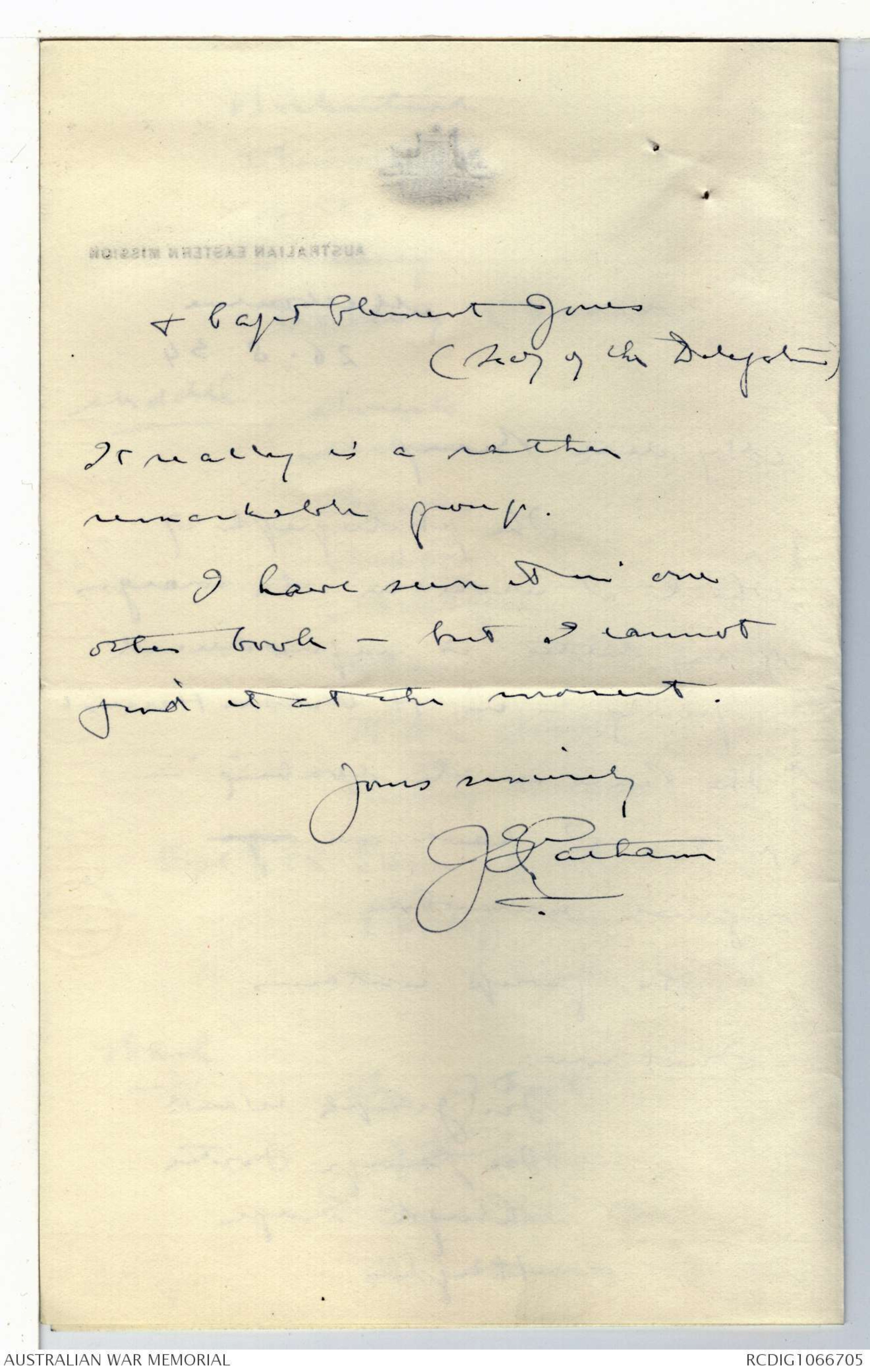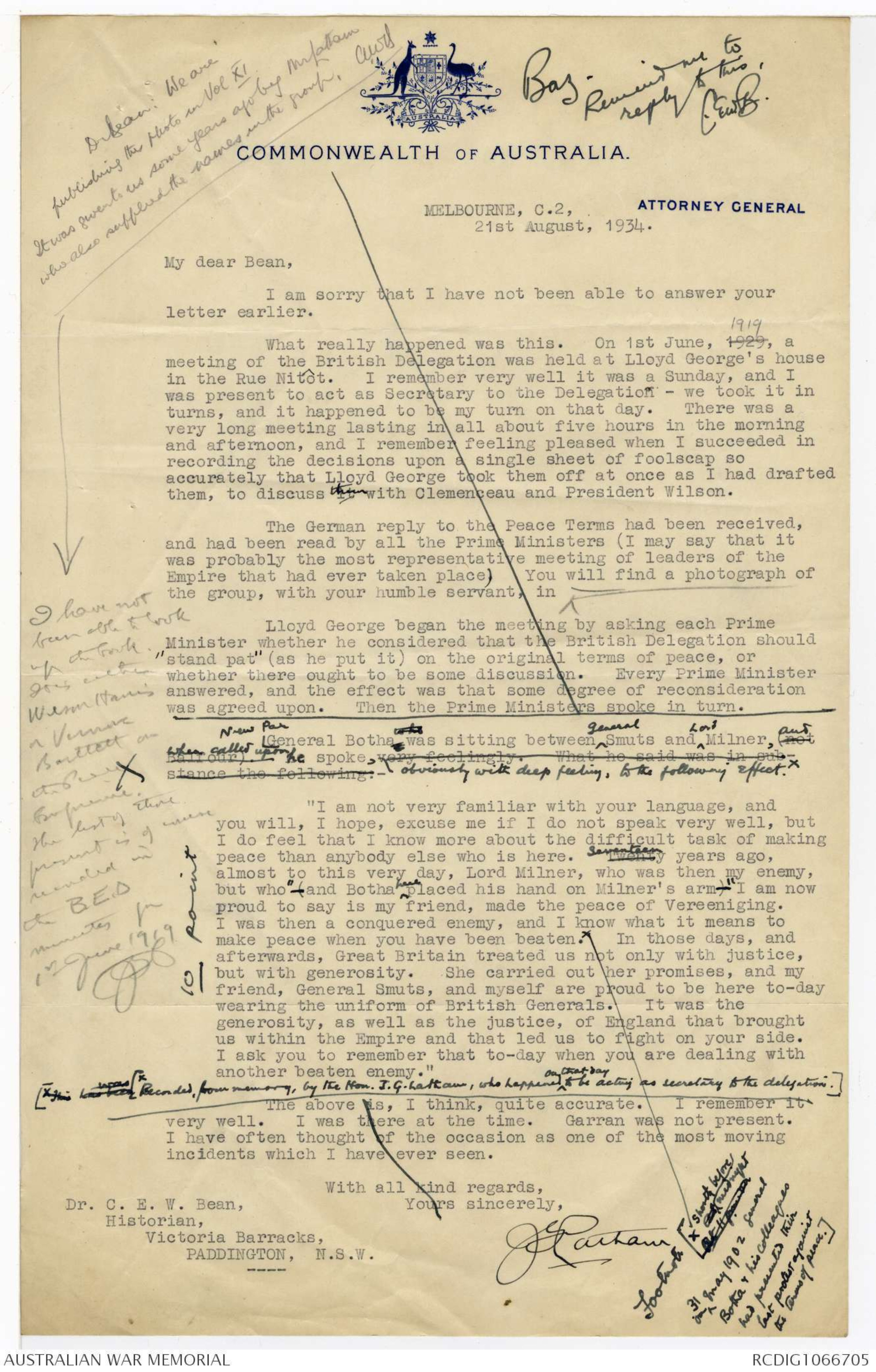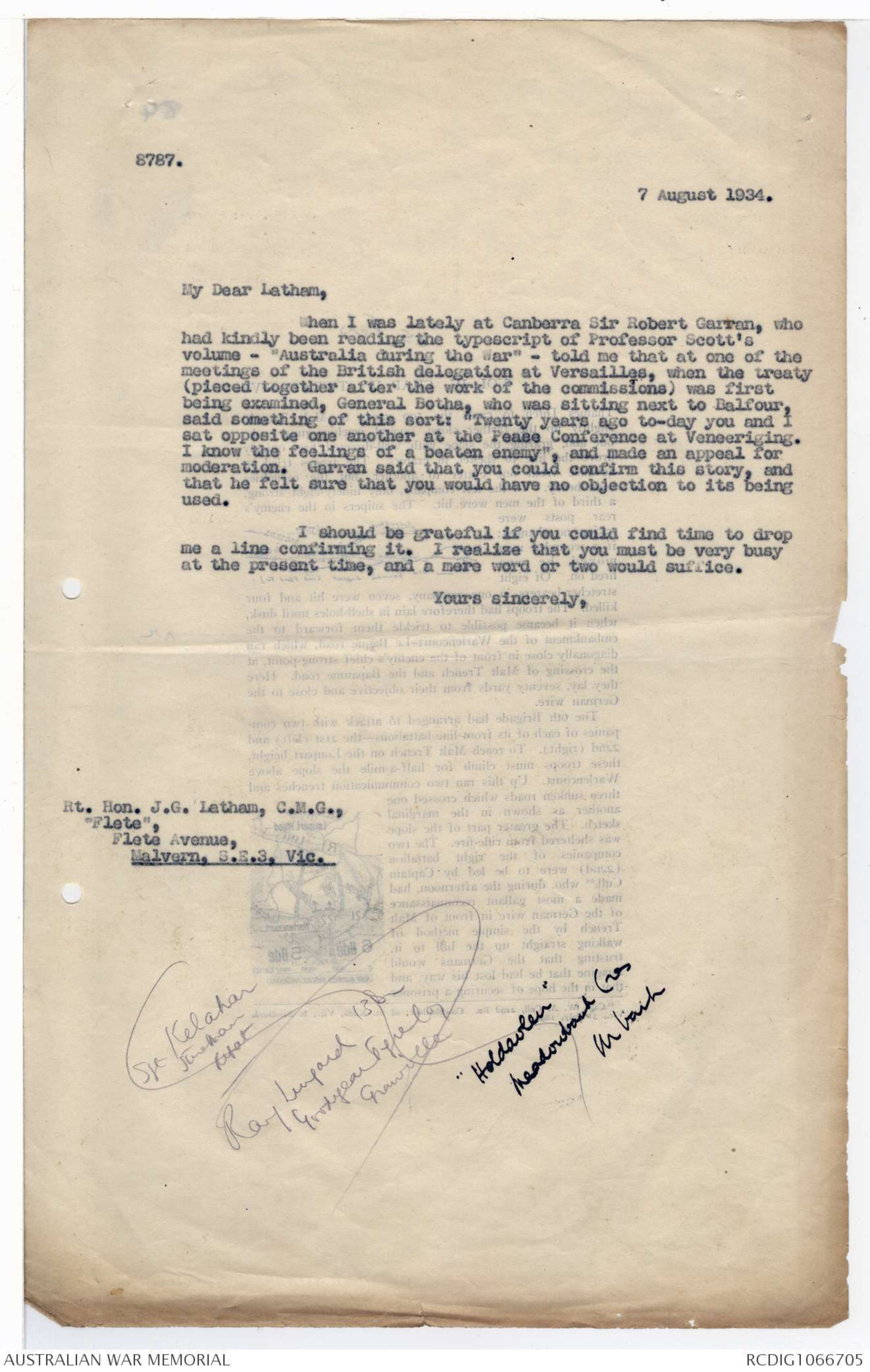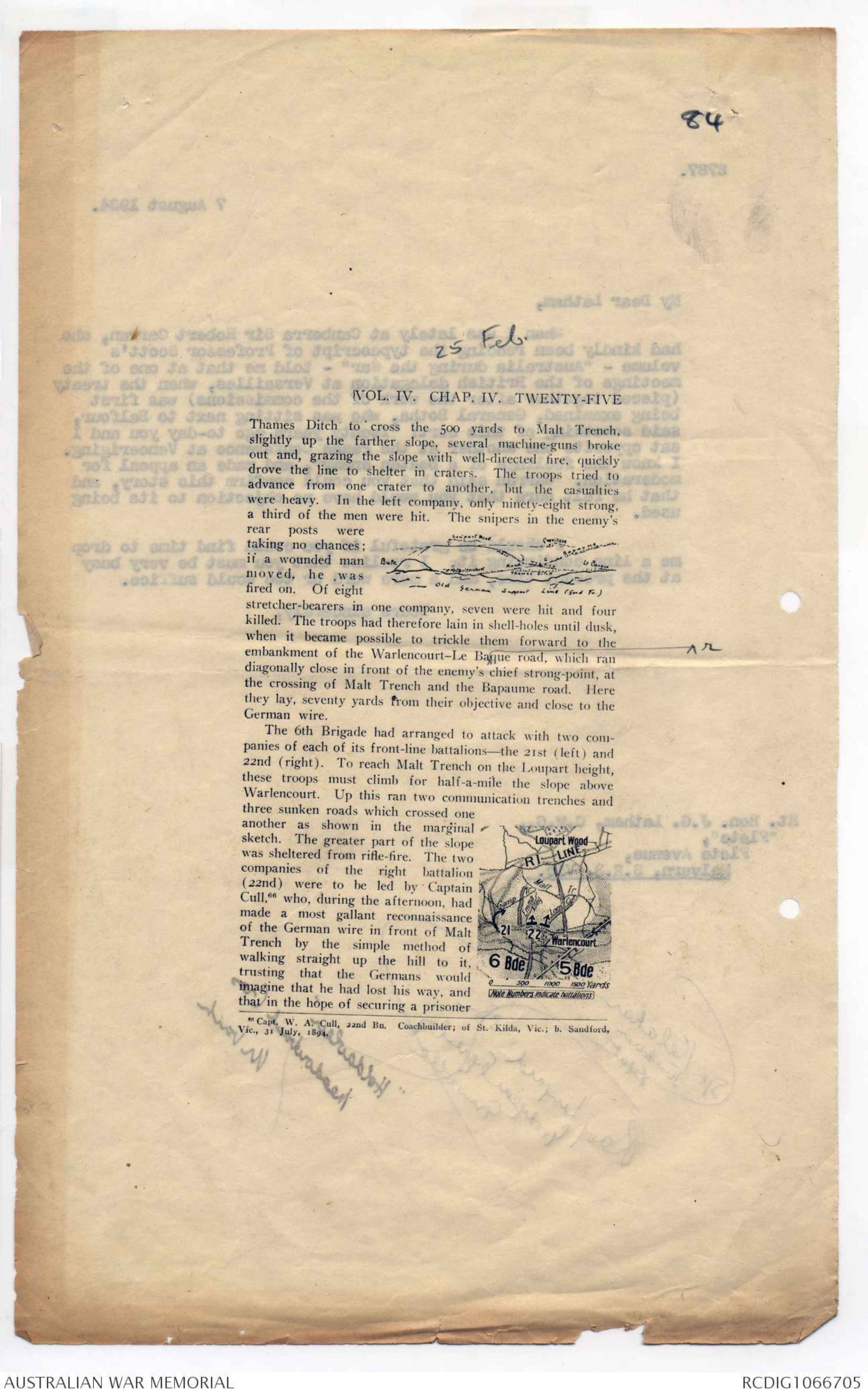Charles E W Bean, Diaries, AWM38 3DRL 606/269/1 - 1918 - 1936 - Part 9






AUSTRALIAN EASTERN MISSION
Melbourne
26.8.34
My dear Bean/
The photograph of
which I wrote in the margin
of my letter is reproduced
- poorly - in H. Wilson Harris'
"The Peace in the making"-
p 49. I have an orgi.
original somewhere.
The group contains
-Front row:
Sir Joseph Ward
Sir George Foster
Lloyd George
Hughes
& Capt Clement Jones
(Secy of the Delegation)
It really is a rather
remarkable group.
I have seen it in one
other book - but i cannot
find it at the moment.
Yours sincerely
JG Latham
Birkenhead
Churchill
Botha
Massey
Doherty (Canada)
Middle
Smuts
Milner
Barnes
Balfour
Montegu
Chamberlain (G)
H H C Fisher
Henry Wilson
Capt E.F.C. Lane (S.A. Secy)
Philip Kerr
(Lord Lothien)
Back
Sir J Cook
JG Latham
Admiral Herd
Sir Maurice Hankey
[*Baz.
Remind me to
reply to this.
C.EW B.*]
COMMONWEALTH OF AUSTRALIA.
MELBOURNE, C.2. ATTORNEY GENERAL
21st August, 1934.
[* Dr Bean. We are
publishing the photo in Vol XI
It was given to us some years ago by Mr Latham
who also supplied the names in the photo. AWG*]
My dear Bean,
I am sorry that I have not been able to answer your
letter earlier.
What really happened was this. On 1st June, 1929 1919, a
meeting of the British Delegation was held at Lloyd George’'s house
in the Rue Nitôt. I remember very well it was a Sunday, and I
was present to act as Secretary to the Delegation - we took it in
turns, and it happened to be my turn on that day. There was a
very long meeting lasting in all about five hours in the morning
and afternoon, and I remember feeling pleased when I succeeded in
recording the decisions upon a single sheet of foolscap so
accurately that Lloyd George took them off at once as I had drafted
them, to discuss them with Clemenceau and President Wilson.
The German reply to the Peace Terms had been received,
and had been read by all the Prime Ministers (I may say that it
was probably the most representative meeting of leaders of the
Empire that had ever taken place.) You will find a photograph of
the group, with your humble servant) in ^
[* I have not
been able to look
up the book.
It is either
Wlm Harris
or Vernon
Bartlett at
the Peace
Conference.
The list of those
present is of course
recorded in
the B.E.D
minutes for
1st June 1919
JRL *]
Lloyd George began the meeting by asking each Prime
Minister whether he considered that the British Delegation should
"stand pat" (as he put it) on the original terms of peace, or
whether there ought to be some discussion. Every Prime Minister
answered, and the effect was that some degree of reconsideration
was agreed upon. Then the Prime Ministers spoke in turn.
X New Par[ General Botha was sitting between ^ General Smuts and, ^ Lord Milner, (not and
Balfour when called upon he spoke, very feelingly. What he said was insubstance the following:- obviously with deep feeling, to the following effect. x
"I am not very familiar with your language, and
you will, I hope, excuse me if I do not speak very well, but
I do feel that I know more about the difficult task of making
peace than anybody else who is here. Twenty Seventeen years ago,
almost to this very day, Lord Milner, who was then my enemy,
but who " - (and Botha ^here placed his hand on Milner’s arm) " I am now
proud to say is my friend, made the peace of Vereeniging.
[* 10 point*]
I was then a conquered enemy, and I know what it means to
make peace when you have been beaten. x In those days, and
afterwards, Great Britain treated us not only with justice,
but with generosity. She carried out her promises, and my
friend, General Smuts, and myself are proud to be here to-day
wearing the uniform of British Generals.) It was the
generosity, as well as the justice, of England that brought
us within the Empire and that led us to fight on your side.
I ask you to remember that to-day when you are dealing with
another beaten enemy.
[* [ x This has been was [xRecorded, from memory, by the Hon. J.G. Latham, who happened ^ on that day to be acting as secretary to the delegation.] *]
The above is, I think, quite accurate. I remember it
very well. I was there at the time. Garran was not present.
I have often thought of the occasion as one of the most moving
incidents which I have ever seen.
With all Kind regards,
J.G. Latham
[* Footnote [ x shortly before
xxx midnight
xxxxx
On ^ 31 May 1902 General
Botha & his colleagues
had presented their
last protest against
the terms of peace.] *]
Dr. C. E. W. Bean,
Historian,
Victoria Barracks,
PADDINGTON, N.S.W.
8787.
7 August 1934.
My Dear Latham,
When I was lately at Canberra Sir Robert Garran, who
had kindly been reading the typescript of Professor Scott's
volume - "Australia during the war "- told me that one of the
meetings of the British delegation at Versailles, when the treaty
(pieced together after the work of the commissions) was first
being examined , General Botha, who was sitting next to Balfour ,
said something of this sort : "Twenty years ago to-day you and I
sat opposite one another at the Pease Conference at Veeneeriging.
I know the feelings of a beaten enemy'', and made an appeal for
moderation. Garran said that you could confirm this story , and
that he felt sure that you would have no objection to its being
used.
I should be grateful if you could find time to drop
me a line confirming it. I realise that you must be very busy
at the present time, and a mere word or two would suffice .
Yours Sincerely,
Rt. Hon. J.G. Latham, C.M.G.,
"Flete"
Flete Avenue ,
Malvern . S.E.3 Vic.
[* Sgt Kelahar
[[?Stretham]]
Repat*]
[* Ray Lingard 13 Bn
Goodyear Tyre Coy
Granville *]
[* " Holdavlen"
Meadowbank Cres
Mbank *]
84
25 Feb
[VOL. IV. CHAP. IV. TWENTY-FIVE
Thames Ditch to cross the 500 yards to Malt Trench,
slightly up the farther slope, several machine-guns broke
out and, grazing the slope with well-directed fire, quickly
drove the line to shelter in craters. The troops tried to
advance from one crater to another, but the casualties
were heavy. In the left company, only ninety-eight strong,
a third of the men were hit. The snipers in the enemy's
Diagram - see original document
rear posts were
taking no chances;
if a wounded man
moved, he, was
fired on. Of eight
stretcher-bearers in one company, seven were hit and four
killed. The troops had therefore lain in shell-holes until dusk,
when it became possible to trickle them forward to the
embankment of the Warlencourt-Le Ba^rque road, which ran
diagonally close in front of the enemy's chief strong-point, at
the crossing of Malt Trench and the Bapaume road. Here
they lay, seventy yards from their objective and close to the
German wire.
The 6th Brigade had arranged to attack with two companies
of each of its front-line battalions—the 21st (left) and
22nd (right). To reach Malt Trench on the Loupart height,
these troops must climb for half-a-mile the slope above
Warlencourt. Up this ran two communication trenches and
Diagram - see original document
three sunken roads which crossed one
another as shown in the marginal
sketch. The greater part of the slope
was sheltered from rifle-fire. The two
companies of the right battalion
(22nd) were to be led by Captain
Cull, 66 who, during the afternoon, had
made a most gallant reconnaissance
of the German wire in front of Malt
Trench by the simple method of
walking straight up the hill to it.
trusting that the Germans would
imagine that he had lost his way, and
that in the hope of securing a prisoner
66 Capt. W. A. Cull, 22nd Bn. Coachbuilder, of St. Kilda, Vic; b. Sandford,
Vic., 31 July, 1894.
 Sam scott
Sam scottThis transcription item is now locked to you for editing. To release the lock either Save your changes or Cancel.
This lock will be automatically released after 60 minutes of inactivity.